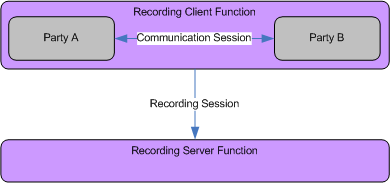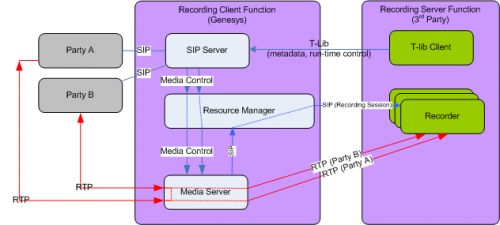Overview
Active Recording Ecosystem Overview
The Active Recording Ecosystem uses Media Stream Replication (MSR) for a fully Active recording solution with Dual Channel Recording. SIP sessions to the recorder provide basic call information and voice (Real-time Transport Protocol (RTP)) data. MSR is where Media Server replicates the RTPs and makes them available to the recording server. Additional events and information are provided by the T-Server part of SIP Server.
Recording Server Function—The recording server function is a logical function that acts as the collector of the recorded media. The recording server is also a SIP User Agent that negotiates the parameters for the recorded media, and typically uses CTI to receive call metadata as well as run-time controls. The recording server function also provides the capability to search and retrieve recorded media, and may provide real-time analysis of the media. The term "server" does not necessarily mean that the recording server only functions as a server; the recording server is also a T-lib client.
Recording Client Function—A SIP User Agent that acts as the source of the recorded media. This is a logical function that may span across multiple components, specifically: the combination of SIP Server and Media Server is the recording client function in Genesys environment. In some environments, the recording client function may be the combination of the switch and the handset.
Communication Session—The session created between the endpoints, such as a conversation between the customer and the agent. The Communication Session, sometimes also called the Recorded Session, may be on any transport, but for Genesys, SIP Server is managing the Communication Session, so the transport is SIP.
Recording Session—A session created for the purpose of recording a Communication Session. The Recording Session is SIP. Multiple Recording Sessions can be applied to a single Communication Session.
This diagram illustrates the relationship between a Communication (or Recorded) Session and a Recording Session.
This diagram illustrates the relationship between the Recording Client and Server functions, from the point of view of SIP Server and Media Server.
Core Capabilities
The following is a list of some of the core capabilities of the Active Recording Ecosystem.
- Full-time recording—Record every call for a specific DN through configuration.
- Selective recording—A recording decision is made to record a call when the Communication Session is first established. T-lib recording functions are provided to allow third parties such as a routing strategy or a business rule to make the decision to record the call.
- Dynamic recording—Recording Sessions are established on an as-needed basis after the Communication Session is established. T-lib recording functions are provided to allow third parties, such as Agent Desktop, to record on demand.
- Pre-recording—Pre-recording is an extension to selective recording that starts the recording when the Communication Session is being established. The recording server function provides the ability for third parties, such as Agent Desktop, to request call recording at any time during the call (and even shortly after the end of the call) for the call to be recorded in its entirety.
- A call recording can be started while supervisor monitoring is enabled.
- Real-time control of the call recording—The recording can be paused and resumed on demand by the agent, or by the workflow when the customer is providing sensitive data such as a PIN.
- The ability to integrate with a third party recording server to receive the call recording for real-time monitoring and quality analysis:
- Multiple simultaneous Recording Sessions can be active for the same Communication Session for different purposes.
- The call can also be recorded locally while streaming to third party recorders.
- Support of secured communications such as SIPS and SRTP.
Deployment Model
Genesys provides the Recording Client Function and is composed of the following core components:
- SIP Server—Handles communication sessions.
- Genesys Voice Platform (GVP) Media Server—Provides media stream replication for the third party recorder.
- GVP Resource Manager—Locates the addresses of a cluster of third party recorders.
A third party recorder provides the Recording Server Function, and is composed of two core components:
- T-lib client—Initiates recording requests to specific calls for dynamic recording and run-time controls for pause and resume functions. The client also receives call metadata from T-lib events.
- Recorder—A SIP User Agent that handles recording sessions and persists the replicated media streams.
When a recording request is initiated, SIP Server directs the media of Party A and B towards Media Server. SIP Server uses media control to instruct Media Server to replicate media stream towards the media recorder. When Media Server receives the media streams, the media stream establishes a recording session (a SIP dialog) towards the third party call recorder. For more information about recording sessions, see Media Server Recorder.



